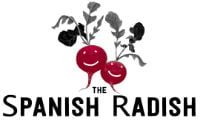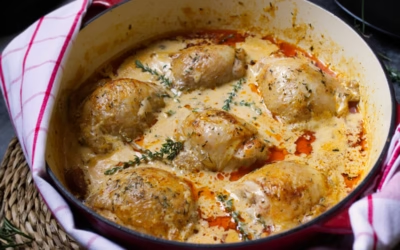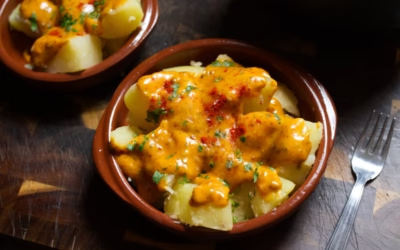Spain Regional Guides – For Foodies!
Explore the wealth of delicious food, fresh produce, wines, and recipes that beat at the heart of Spanish cuisine.
Our comprehensive Spain regional guides are made for foodies, by foodies!
The Beauty of Spain, Explored One Mouthful at a Time!
There are 17 autonomous regions of Spain, all offering a wealth of natural resources and fresh produce. From the bustling streets of the capital of Madrid, stunning mountainous regions of the north to the pristine blue shores of the Mediterranean sea, our regional guides delve deep into the culture, produce, and culinary traditions of Spain and its people.
Discover the diverse Spanish landscape and cuisine, through recipes and world-class produce from every region.

The North
Asturias
Asturias, above any other region in Spain, offers some of the greatest diversity in cuisine that blends sea and mountain ingredients, with premium-quality beef, fish, and cheeses, as well as shellfish, fine wines, and ciders. Our Asturias regional guide will take you on a culinary tour to explore this exceptional region of Spain.
Cantabria
Cantabria is a charming region nestled in the northern part of Spain. It’s known for its rich history, cuisine, and natural beauty.
This Cantabria foodie guide will explore the most popular dishes from the region, plus look at famous produce from the region, including food and drinks.
The Basque Country
Straddling part of the border between France and Spain, the Basque Country (País Vasco) has an incredibly diverse landscape that extends far beyond the renowned foodie capitals of larger cities such as San Sebastian and Bilbao. While the region is small, it has the highest concentration of Michelin-starred restaurants in the world per capita.
Galicia
Exploring the far northern Galicia region by food is like opening a foodie treasure trove. With a rugged coastline that divides two seas, undulating hills, and large fertile plains that benefit from the highest annual rainfall in Spain. Galicia is blessed with exceptional quality fresh produce, seafood, meat, and dairy products at every turn.
Galician cuisine is perhaps most famous for the stunning dessert, the Tarta de Santiago, but visitors to the region should take time to explore the many delicacies and dishes that are made in the region.
The Community of Navarra
The region is defined by a rugged yet picturesque landscape, with the Pyrenees mountains bordering France to the east, and fertile zones along the Ebro river which is considered a lifeline to the many farms along its banks.
This Navarra foodie guide will explore the most popular dishes from this region in the north of Spain, plus look at famous produce from the region, drinks, desserts, and wines. We’ll also cover how to get to the Navarra region, and what is not to be missed once you are there!
La Rioja
Explore the beautiful region of La Rioja with our La Rioja Regional Foodie Guide. Packed with local cuisine, La Rioja wines, and other produce not to be missed, The picturesque region is a highlight for any foodie tour.
One of the most notable features of La Rioja is its stunning landscape, which is characterized by rolling hills, picturesque vineyards, and rugged mountain ranges. The region is also home to several rivers, including the Ebro river, which provides a vital source of water for the local agriculture and wine production in the northern part of the region.
The Center
Aragon
Located in northeastern Spain, Aragon is a fascinating region with a rich history, diverse landscape, and vibrant culture. From the Pyrenees mountain range to the Ebro River Valley, Aragon is a place of striking contrasts and natural beauty.
Aragon is also somewhat of an unsung hero in Spanish cuisine and culture, and many newcomers to Spain will not know of this beautiful and diverse region. Discover the cuisine of this beautiful region of Spain with our Aragon Foodie Guide. What To Eat, Regional Produce, Recipes, And Travel Tips.
Castilla y León
Our Castilla y León regional foodie guide has everything to help you discover the wealth of local cuisine, delicious recipes, wine, and produce from the region
Exploring Castilla y León’s diverse culinary history will take some time mainly due to it being the largest autonomous region in Spain, but delve into the traditional recipes and produce of Castilian-Leonese cuisine, and you won’t be disappointed.
Extremadura
Extremadura has a rich culinary tradition that reflects its rural heritage and Mediterranean climate. The region’s cuisine is characterized by its simplicity and use of local ingredients, such as olive oil, garlic, and paprika.
It is known for its rugged landscape, rich history, scorching summer temperatures, and traditional way of life. In this article, we will explore the region’s climate, inhabitants, industries, food and drinks, and other interesting features that make Extremadura a unique destination for travelers and food lovers!
Castilla La-Mancha
Located in the middle of the Iberian Peninsular lies a region with rich umber-colored soil that glistens in the hazy afternoon sun. Castilla-La Mancha is home to a rich culinary history, dotted with many unique inland towns and cities that are scattered throughout the inland plateaus and stunning snow-capped mountain ranges.
From the hanging houses of Cuenca, to the stunning former capital of Spain, Toledo, all are homage to the region’s embrace of simple and hearty cuisine, shaped in part from their neighboring regions, and also in part influenced by a strong agricultural and pastoral origin.
Madrid
They say that all roads lead to Madrid and a small stone slab lies discretely within Madrid’s Sol Plaza celebrating the geographic kilometer ZERO of Spain. But, it’s just a short stroll in any direction where you’ll find the rich aromas of authentic Spanish food wafting from the alleyways and narrow cobbled streets that are lined with Madrid’s famous tapas bars and prestigious restaurants.
Madrid is not only the geographic center of Spain but also the renowned melting pot where Spain’s culinary cultures merge. This is no more evident than in the enormous range of Spanish and international cuisine on offer throughout the capital, and with nearly 10,000 restaurants within the Madrid region, you’re spoilt for choice!
The South
Andalusia
It is almost unimaginable that so many famous dishes and world-class produce come from this region. From rich farming communities that produce the Iberian pig (Jamón ibérico), to the expansive region of Jaen, responsible for a majority of Spain’s olive oil production., there’s so many dishes to be sampled at least once, or maybe even twice!
The East (Mediterranean)
Catalonia / Cataluña
The Catalonia region is perhaps best known for its thriving capital, Barcelona, but a close second when you mention Catalonia is the food. The region offers a wealth of authentic Spanish cuisine that has resonated all around the world.
With its borders spanning from the Mediterranean Sea in the east, to the stunning rugged grazing plains of Aragón, to the picturesque mountainous zones of the Pyrenees mountain ranges, the Catalonia region has it all!
The Valencia Region
With its white-sand beaches and turquoise water of the Mediterranean Sea, the Valencia region harbors some of the best cuisine and fresh produce in Spain. Orange groves are dotted all the way up and down the region, and the rich fertile soil makes for ideal vineyards, producing excellent wines. It’s also one of only two UNESCO-listed locations for gastronomy and is home to many of Spain’s most renowned restaurants.
The Region of Murcia
The Murcian landscape is pockmarked with almond orchards, orange and olive groves, plus a wide range of fresh fruit and vegetable orchards. The prosperous agricultural land grows around quaint villages and towns, many of which are built around historic medieval ruins or roman castles and are steeped in history.
The fruitful landscape is evident in the food found throughout the region of Murcia. The locals share a fondness for fresh ingredients such as fruit and locally grown vegetables, plus recipes that require the freshest seafood and fish. Meat dishes are often served as hearty broths and stews and beef and pork are favorites throughout the region.
The Islands
The Balearic Islands
Scattered within the crystal blue waters of the Mediterranean sea, the Balearic Islands is an archipelago off the eastern coast of Spain that boasts an incredible gastronomic culture. Each island harbors its own specialty dishes whilst also sharing an appreciation for the many neighboring island dishes as well as drawing culinary influence from neighboring Catalan and Valencian communities.
A trip to the Balearic Islands is surely a treat for the tastebuds and well worth exploring one mouthful at a time! Let’s check out each island and discover its own unique appeal and what’s not to be missed!
The Canary Islands
Culminating off the west coast of northern Africa, the Canary islands have always sat at the crossroads between America and Europe. Perhaps this is why the cuisine is diverse and interwoven with influences from the world over.
Explore the cuisine of the Canary Islands with our regional foodie guide. discover what to order, what produce to look out for, drinks to tipple, and wines to enjoy, plus plenty of recipes to take home!
Our Blog
Roscón de Reyes: Spain’s Most Playful Christmas Cake
Roscón de Reyes: Spain’s Most Playful Christmas Cake 👑🍊If Christmas in Spain had a grand finale dessert, this would be it. Roscón de Reyes is the sweet, crown-shaped cake that takes centre stage on Día de los Reyes Magos (Three Kings Day),...
Creamy Paprika-Infused Chicken Thighs
Creamy Paprika-Infused Chicken Thighs This Spanish creamy paprika-infused chicken thighs with chorizo recipe makes for an easy one-pan dinner. Tender, golden chicken thighs seasoned with plenty of fresh herbs and Spanish sweet...
Spanish Potatoes Mozarabic – Patatas Mozárabes
Spanish Potatoes Mozarabic - Patatas Mozárabes: A Classic Andalusian Tapa Mozarabic potatoes are a classic Andaluz tapa (known as Patatas mozárabes in Spain). There are many variations of Mozarabic potatoes, and each has their...




Awesome website. We’re traveling to Madrid, Seville, and Valencia and can’t wait to use your tips. Thanks.
Thank you! and fantastic to hear of your upcoming travels! We have plenty of information on Spanish food and culture, plus we also have some Tapas walking tour guides for Madrid and Valencia that are free to download. Happy travels!
https://thespanishradish.com/spain-regional-guides/madrid-regional-foodie-guide/
https://thespanishradish.com/spain-regional-guides/valencia-regional-guide/